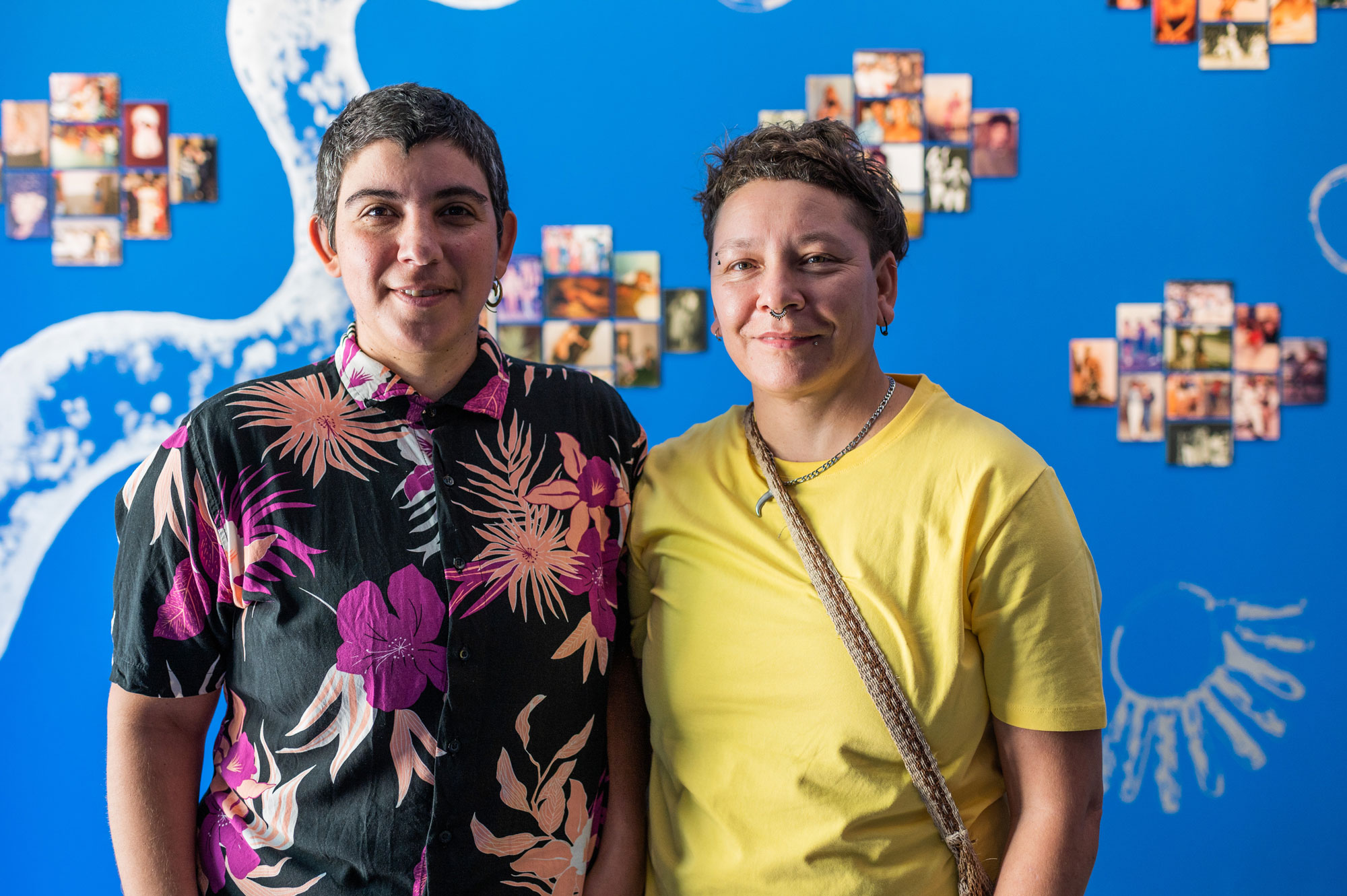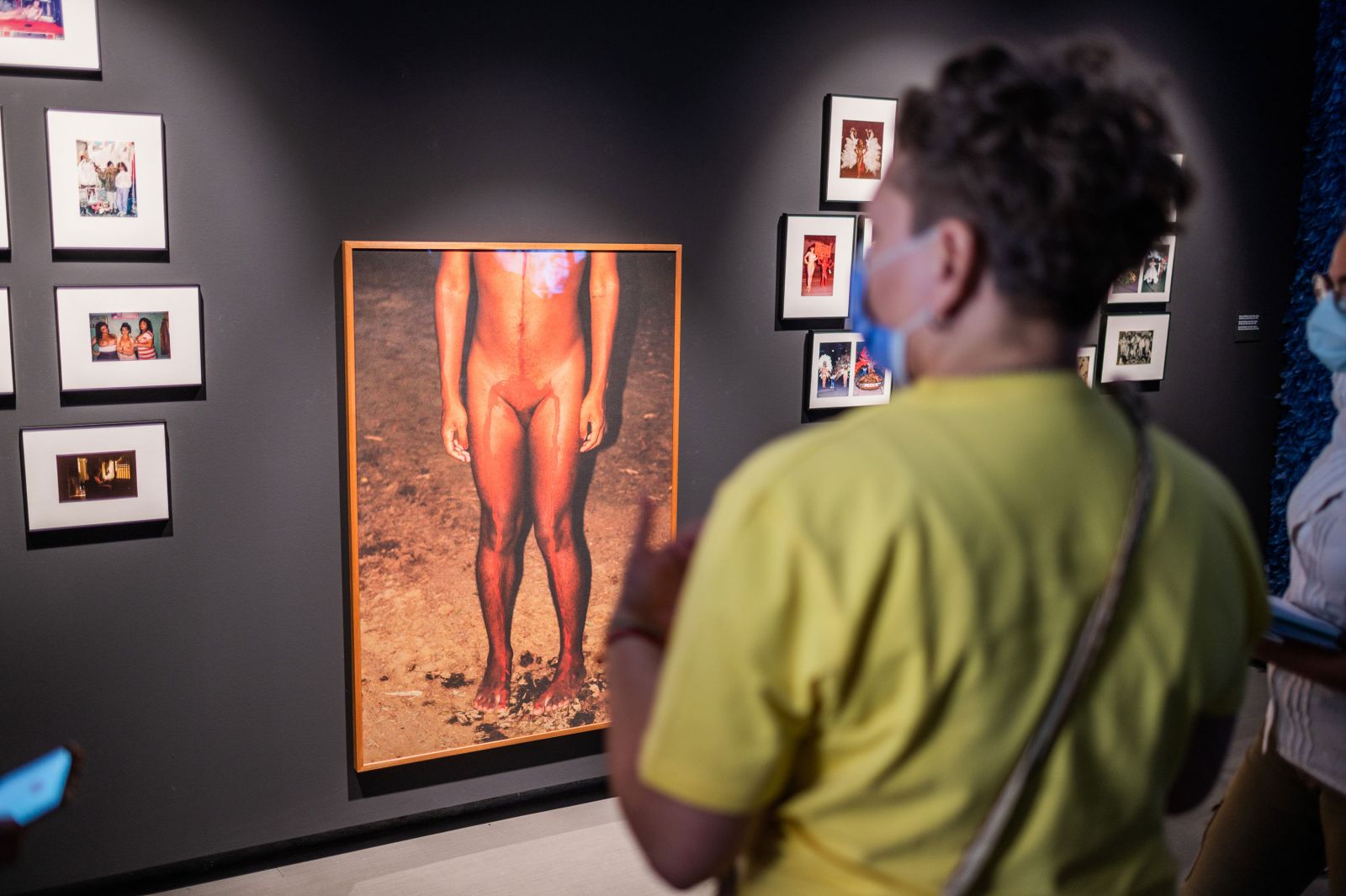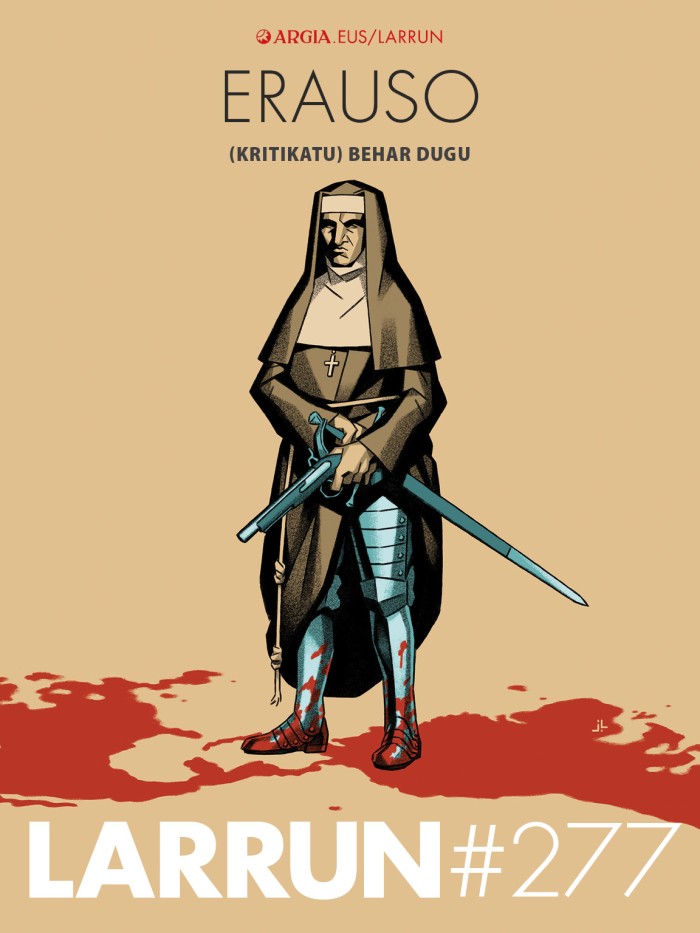“We honor the victims of colonization, not the winning hero”
- We know the voice and face of Catherine/Antonio Eraus, but we know nothing about the dissidents of gender massacred and enslaved by settlers like this. The work of Rio Paraná focuses on immersing in historical archives to recover memory and stolen dignity, a group of visual artists, performers, trans-Argentine writers and researchers, Du Sacchi and Mag de Santo.

The anticolonal artistic projects and spoons of Río Paraná include the Indian massacres of centuries of conquest, but also the current persecution against dissidents: forced disappearances, transnational estractivism, institutional violence against indigenous nations or travesticide. They make counter-expeditions to Europe to tell the story of the destroyed, desecrated and visible in anthropological museums.
"Perhaps Erauso's only celebrable feature is his survival as a trans person, but history still names Catalina as a bishop, the synthetic and oxymoronic sum of the two great models of Western humanity." In 2021 in the La Virreina room of Barcelona and in 2022 in the Museum of Contemporary Art of Panama, they wrote the phrase for the catalog of La pisada del Ñandú. In this exhibition, in which Erauso is an invited guest, the trans, transvestites and non-binary people of Abya Yala are protagonists, both the contemporary citizens that hosts the Archive of the Trans Memory of Argentina and those who were named weye, muxe or bixa.
From the image of Eraus, Rio Paraná is interested in his participation in the indigenous genocide, since it is not a small detail of his biography, but a fundamental element that explains the destiny and fame of his life. In any case, they stress the need to focus attention on the victims of the colonial process and not so much on the perpetrators, even if they are very little.
How did they know Erauso?
D. Sacchi: I met Eraus while researching for this exhibition, but I wasn't very interested. I related corsaries to those stories that are girls. We did not seek to demonstrate the historical existence of transs – we did of course – but to serve as an example of co-dependence between colonialism, racism and the construction of gender binarism. In the archives of the South American Inquisition, I found cases judged by trans masculinity, mostly black or indigenous. They were not killed, but they had to leave their communities and they were removed from history. In one of these cases Erauso is cited.
At the same time, at the Museum of America we were reviewing the collections in order to bring anthropological exhibitions to art museums. Lots of pieces were good examples of the nonbinary genre. In an anthropological exhibition at the Museum of America, I discovered that the painting by Erauso was considered an example of non-binary identity. After searching Google, I got thousands of entries left over the character and we saw that the painting was in Kutxa. We also discovered more information in the Chilean file, where he was named a conqueror, and there he began to interest me in the character. The position of Alférez is not any position, but that which marks the flag in the conquered territory. Therefore, we included the picture of the settler in the exhibition of Barcelona to contextualize it, as it was especially significant in La Virreina.
M. De Santo: I'm interested in another line of research: how Erauso is built on that fictional self-consumption. In short, because through him he sought to persuade the Pope and the King to receive the life allowance for their work in the colony. What he counts makes no sense, for example, that he walked through the Andes. It is said that he received the Pope's buck, but we have not found any record to prove it. It's also very difficult for anyone to realize it was a transaction. I was fascinated by the novelty of the work and because the text intersects two literary genres that have worked in Europe as an instrument of femininity and masculinity: the intimate diary of nuns and the chronicle of the Indies. I was surprised how she went from being a heroic man to being a woman who recognizes herself as a virgin; how she goes from a very external account to telling that midwives proved to be vagina and hymen.
It is an available document, it was not lost and has been reedited. In addition, a well-known writer in Argentina, Gabriela Cabezón Cámara, puts a lesbian prologue. Films have also been made. But of course, that's because it's white. We know that in Mexico, a children's leaflet was sold in kiosks on a potter's nun that functioned as colonial propaganda.
“We have to break with the charm of power. We have to get Erauso to be seen as a murderer, a cruel subject that nobody wants to conquer”
MAG DE SANTO
The reading of white feminism is that it avoided the oppression of gender disguised as man, as did the warrior Joan of Arc. We emphasize that he was an Indian murderer and from there he built his masculinity. We want to make a counter-expedition of the trip Erauso reported: to undertake the reverse path to the settler to find other readings. He inherited goods like Antonio, which means that at that time he made a complete transition, when we still cannot inherit with the name chosen in the 21st century. Of course, he got those changes in his economic and racial position.

D. Sacchi: It tends to hide the colonial part, which is mentioned as a small problem of the character. But we compared ourselves with other characters pursuing punishment, exile or death, such as Eleno Cespedes, born and grown a little earlier in the Spanish context. In the case of Erauso, it is a letter that he wrote directly to the king and the response of the king. In contrast, Caespedes appears only in the documents of the Inquisition, we have no voice.
M. de Santo: Cespedes was a slave and libertarian, but achieved social ascension by being a surgeon and working high. When they heard that he was trans, he was convicted, beaten and charged with having a pact with the devil. It is clarifying, the white has face and voice, books and films, while there is no account or portrait of African origin. They say they sent him to the Indies, but it's not confirmed. In the exhibition we also include video performance You will never be a weye (You are never weye) by Sebastián Calfuque. It refers to the massacres that occurred in one of the indigenous communities where Erauso killed more people in Chile and the destruction of gender identity. Thus, we show three different treatments for trans people based on their territorial location. This asymmetry is currently maintained: those who have power count themselves and the "others", in an alterity position, are counted. The first Inquisition persecuted us and today the police.
D. Sacchi: Erauso’s painting was not introduced in Barcelona to honor him as the first trans, but to directly challenge his descendants and show this colonial structure. It was very fun to see how the cultural authorities of Barcelona valued the painting as a teacher of Velázquez, Francisco Pacheco. We, on the other hand, gave more importance to a good reproduction of the Cespedes documents.
M. de Santo: The management of La Virreina had no doubt about the transport and conservation of the monetary spending table. There was a fascination for the object, that we didn't share, and we preferred to devote all that money to the trans artists that live. In addition, at one point, they said that the painting was not of Pacheco, but of Juan Van der Hammer, who suddenly lost value.
How do they perceive the role of the Basques in colonization?
M. de Santo: In Buenos Aires we have a very important street called Elcano. And the name of the wife of one of our liberators, Juan Manuel de Rosas, is Ezcurra. The first settlers here were Basques.
D. Sacchi: In the so-called Wars of Independence, most families with military and judicial power were Euskaldunes and, in particular, the heads of the Desert Conquest [a military expedition led by Rosas in 1833, in which pampas, rankels, tehuelches and mapuches were exterminated]. Rosas presented to the Congress of the Nation and to the president his project of moving Euskal Herria to Patagonia. This opportunity was recognized by the Argentinians! And the saddest thing they took as a basis to divide the territory into a multicolony: the Basques here, the Germans there, the Welsh there…
We are interested in showing the continuity between this nineteenth century indigenous genocide and the twentieth century genocides of the Southern Cone, well studied by the writer David Viñas. Under the chairmanship of Nestor Kirchner, trials against the civil-military dictatorship begin to defend truth, memory and justice. Then, one of the actions carried out by the state was to lower the boxes of the dictators. We took inspiration from it and in our exhibition we reduced the painting of Erauso when they walk the American continent to symbolize that continuity.
M. de Santo: Along with the gesture of lowering the chart, we uploaded the files about Cespedes and distributed a few white notebooks so that each one would create their gender autophyche and have that space to build their identity. On the last page we offer our reading about the history of Erauso.
“We don’t want to make Erauso more
famous, you have to lower the
foam” MAG DE SANTO
Cabello/Carceller asks that Antonio be added on behalf of Catalina Erauso Street. Do you agree or should that honor be removed? And what do we do with your bust?
D. Sacchi: I think it is very good to restore the male identity of Eraus because what was once recognized has been erased. But it should also be made clear that he participated in the conquest and genocide. If a monument is removed (as the City Council of Barcelona has done with the slave businessman Antonio López), you have to leave a plate that tells the story erased and that brings memory and truth. However, the action of lowering the Erauso painting leads us to remember that a person is not guilty of everything, but we should look at the broad structure that genocides bear. You can make a genealogical chart of all the Basque families that participated in the conquest!
M. de Santo: In Argentina, it is common for activists to intervene in street names. Public space has a great force in our country, it is easier to turn it into a forum for debate than in the Spanish state. As an artist, we designed a very concrete and thoughtful strategy for each case. We've worked on the colonizer Henry de la Vaulx, who desecrated graves and robbed bodies in Patagonia to show them in European museums. Champs Elysées had a beautiful funeral. For our project, we created a funeral board that defines their bad deeds. Another strategy is to make victims visible and pay tribute: Vasco Núñez de Balboa hit the isthmus of Panama and murdered an entire community; we do not know the names of the victims, we do not have much information about them, but they are at the heart of our project. In other words, instead of continuing to emphasize the heroic victor, we prefer to recover the memory of those who were defeated and who resist the day.
D. Sacchi: These victims were offered a floral offering in which staff from the Panama Museum participated. We often forget the victims, even when we talk about historical revisionism and decolonal visual arts. For example, in the engravings of Théodore, as famous as Bry, the focus [with colonial massacre] is on the perpetrators. Another common mistake is to talk about genocide as if it were an entelechy, and we try not to fall into it. We wanted to demonstrate that this massacre happened at this time, that it has a geolocation, that we can go, that there are heirs from that community, that colonization has not ended and that its consequences continue to this day. In our project on the case of Vaulx (What do you do with our bones? What do they do with our bones?) Scientists, state officials and European accomplices have accompanied us to seek memory, truth and justice. In addition to symbolic justice we have managed to have material: the French State has announced that it will return stolen corpses.

Preciado and Cabello/Carceller emphasize that the portrait of Erauso is the first visual record of a trans person. On the contrary, his work emphasizes indigenous dissidents who have been historically eliminated.
M. de Santo: Europe brought Abya Yalara the naturalization of sexual dimorphism. At the same time, they have imposed a single homogenizing and universal form of being trans, which Eraus configures: white masculinity, closed, passing and institutional recognition, which is built on the dissolution of others. When it is confirmed that it was the first transaction, the experiences that destroyed the colonization process are imbisified.
D. Sacchi: We don't mean that Abya Yalan wasn't a gender binarism, but he wasn't as widespread as in the white West, but he thought of femininity and masculinity. The figure of Erauso trans is more understandable to the West and to us when compared to the sexemolytic diversity of the peoples of origin. But we have to be clear that that diversity was not one-time, but universal. Otherwise, we will reinforce a deep-rooted bias in Latin America and Africa: that trans identities have come from the West. What has come to us is a single, globalised model.
M. de Santo: However, it is a very European trend to point out that someone was “the first person who does not know what he has done”. Who cares who was first? We find this desire for monumentalization problematic. We're interested in something minor, like local inscriptions. We believe that epic gestures cannot lead us to places of interest.
D. Sacchi: That reminds me of Elcano, the first man to turn around the world. In the Pacific and the Atlantic there were ancestral navigating communities, but perhaps they were not interested in turning around the world, because it is a very European ambition.
Cabello/Carceller defends Erauso that his vocation was not military but commercial.
D. Sacchi: Trade in this context involved slave trade, land and indigenous resources. What other kind of trade did the colony have?
SACCHI
with “You could make a family tree of the Basque families who participated in the conquest”
M. de Santo: And he was pirate ahead!
This LARRUN aims to use icons like Erauso to stimulate anticolonal reflection. Do you see it right?
M. de Santo: We don't want to make Erauso more famous, we need to lower the foam. If we talk about it, then let's talk about its terrible actions so it doesn't generate identification through the mirror effect. I recognize that when I read Erauso's autobiography, I had to fight myself, because I felt a certain fascination. I come from a bleached urban context and have been taught to want to be like a settler since I was young. We have to break with the charm of power. We have to get Erauso to be seen as a murderer, a cruel subject that nobody wants to conquer.
D. Sacchi: I was not surprised, perhaps because in my country of origin and in the history of my family both colonization and indigenous resistance are more present. Should we find other landmark benchmarks so that LGTB isn't the only mirror of people?
D. Sacchi: A genocidal one will never be a benchmark for me. Would my opinion of Videla [Jorge Rafael] change if I knew it was trans? Why is Eleno Cespedes not a benchmark in Europe? Maybe racism has something to do with it.
M. de Santo: And classisms.
D. Sacchi: If we discover in the archives of the Inquisition many trans black and indigenous people, anyone can find other figures in the Basque Country, especially considering that the Basques have a special relationship with gender binarism. That is, any amatxu in the farmhouse can be a better benchmark than Erauso.
The following articles are also part of this LARRUN:
Icon of Monja Alférez as a stimulus for trans and anticolonial debate
Despite the black skin and curly hair, they remained invincible men, with the intelligence and resentment of human beings.” So he wrote about the slaves CRL James in the book Jakobino Beltzak, who masterfully narrates the Haitian revolution. So many brutalities, torture and... [+]
Malin, Burkina Fason eta Nigerren Frantzia haizatua da. Mendebaldeko potentziek haien eragina galtzen ari dira Afrikako kolonia zaharretan. Afrika frankofonoko populazioa bereziki gaztea da, eta ez du frantses kolonialismoa zuzenki ezagutu. 35 urtez peko gazteek populazioaren... [+]
Last week I was at the Olaso Tower in Bergara, in a talk about symbol acquisition.
Behind the symbols there is a story, and it is evident that the symbols we have before us – shields, flags, monoliths, street names… – tell the story that suits the empire.
It is not in... [+]
II. Following the World War, the process of decolonization of the countries of Africa and Asia began. In fact, the soldiers of these countries participated in the triumph of Germany and its fascist allies, and “as a thank you” those subordinate countries had to be recognized... [+]
In the bar Gato de Pamplona was singing screaming, the famous song of curse of Malinche: "Eta oker horretan, pasako grandeza eman egingo dugu, eta oker ants three hundred years Geratu gara slaves."
Having a birth in South America, especially in Colombia, is nothing comfortable,... [+]





















